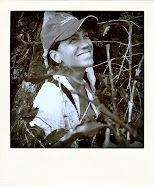 Five and a half miles does not seem like a long trek, unless you are walking in the rainforest. The undergrowth is barely contained by the edges of the trail, and in the least traveled portions, the vegetation slowly creeps over the trail, making walking difficult. Add to that the oppressing heat and humidity, the uneven terrain, the many depressions that tend to fill with water every time it rains, and you have the perfect recipe for slow going. The good thing is we are in very good company. Jenny and I are traveling with my husband, Russ Mittermeier, who is an expert in tropical biodiversity and who spent his youth (and indeed much of his life) running around in these forests chasing monkeys for his scientific studies. We are also with my 12 year-old daughter, Juliana, who is in 7th grade and has already visited over 30 countries and all 7 continents but has never been to Suriname before! Traveling with us is also an enthusiastic and dynamic group of people from Seattle and British Columbia. They are all friends of Renee Harbers, a young and energetic photographer whose husband was instrumental in saving this millenarian forest.
Five and a half miles does not seem like a long trek, unless you are walking in the rainforest. The undergrowth is barely contained by the edges of the trail, and in the least traveled portions, the vegetation slowly creeps over the trail, making walking difficult. Add to that the oppressing heat and humidity, the uneven terrain, the many depressions that tend to fill with water every time it rains, and you have the perfect recipe for slow going. The good thing is we are in very good company. Jenny and I are traveling with my husband, Russ Mittermeier, who is an expert in tropical biodiversity and who spent his youth (and indeed much of his life) running around in these forests chasing monkeys for his scientific studies. We are also with my 12 year-old daughter, Juliana, who is in 7th grade and has already visited over 30 countries and all 7 continents but has never been to Suriname before! Traveling with us is also an enthusiastic and dynamic group of people from Seattle and British Columbia. They are all friends of Renee Harbers, a young and energetic photographer whose husband was instrumental in saving this millenarian forest.
The going is tough because we stop every few minutes to marvel at the details of the forest: a brightly colored heliconia or bird of paradise, a shy mushroom, the call of a bird from high in the canopy, or a troop of squirrel monkeys crossing overhead. Our destination is a cave system that was only discovered 5 years ago. The explorer who found it is a Trio Indian that goes by the name of Kamanha. He is legendary in this area and known throughout the Amazon for his hunting skills. Kamanha, and his good friend Koita were field hands during Russ’ field studies in Suriname almost 30 years ago! Over the past few years they have become field guides to our oldest son, John, who has been doing bird surveys for Yale University and Conservation International in Suriname; the circle continues to go around and today we are guided by Raisa, Kamanha’s oldest son, yet another superb guide. They are all amazing hunters and trackers and they are highly respected in every Indian community from here to Venezuela and Brazil.

In 2004 Kamanha was hunting in this area when his favorite dog went ahead to chase some prey and then didn’t come back. Kamanha chased the animal to a cave where he found ancient petroglyphs carved unto the rocks. The figures depict people and animals and they are crudely carved on the walls of the cave. Few people outside of the Indians, a handful of archaeologists and a few tourists have ever been here and it is a thrill to stand in the cool cave imagining the Indian civilizations who lived here and adorned these rocks with scenes from a long forgotten time.
To wrap up the hike, we go looking for the “cock of the rock”, a bright orange bird with a helmet-like head that lives among these rocky outcrops. We get a glimpse of the bird but cannot get close enough for photograph. We will have another chance in a couple of days, when we visit Raleighvallen in another part of the country.

After we come back to Iwana Samu, we are treated by a visit from Kwamalasamutu. Jonathan, the self-appointed guardian of the Trio culture brings a group of dancers from the village. They are dressed in full Trio costume and they perform a handful of dances. We make sure they know how important this is for us and how much we appreciate it. We all commit funds to a project to help Jonathan revive Trio culture, which has slowly been eroded thanks to the careless teachings of missionaries in this part of the world.








Hola Cristina!
ReplyDeleteVery cool :)
Happy blogging - keep us posted
Cheers,
Sandesh